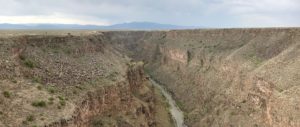Preserve public lands for children yet to come
Richard
Rio Grande Gorge by Daniel Schwen
You have fished for the trophy trout in the Rio Grande in the Rio Grande del Norte National Monument. Or perhaps you’ve hiked Sand Canyon, a bit west of Cortez, and enjoyed the wonderful walking, spring flowers and ancestral Puebloan ruins.
You can kiss these amazing places goodbye if some of today’s politicians have their way. Both the above public lands are controlled by the federal government, as is much of the land in the West. The feds don’t do a perfect job of stewardship, but at least a certain minimum standard of protection is enforced. National monuments restrict and control grazing and extractive industries.
When he was campaigning, Donald Trump pledged to keep public lands under federal control. Unfortunately, ! he is reneging on those promises.
Trump has asked Ryan Zinke, secretary of the Interior, to review 27 of the largest and most recently designated monuments. The idea would be to either abolish these monuments or to decrease their size. It appears that Trump’s motivation is to alter the special monument status for commercial reasons. Yet it is essential that humanity not lose our connection to our land and to our past.
In addition, there are threats to turn control of monuments over to state authorities. At first glance, local control sounds as though it might be a good idea. There would be local or state governments controlling these beautiful parts of our wonderful country. Furthermore, the responsible people wouldn’t need to contact Washington every time they need to buy a new pencil sharpener.
The downside of local control is that local people may! lose sight of the purpose of monuments; they might sell off rights during a time of economic difficulty. Furthermore, locals often don’t have the resources or expertise and would be unable to administer the monuments properly. Many states lack sufficient funds to run their state parks well, let alone take responsibility for national monuments!
National monuments come in all sizes, from a single historical house to the mammoth Papahanaumokuakea Marine National Monument. They were all created by decree by presidents of both parties, on territory that already belonged to the federal government. No president has ever ordered a review before.
Many of the 129 national monuments in the U.S. are of great aesthetic value. Their beauty attracts millions of visitors and is of great value to local economies. Exploration and drilling would spoil their bea! uty and trade short-run profit for long-run ruin.
Bears Ears National Monument was designated at the end of 2016 after years of consideration. It was established with the help of several Native American tribes, who are also involved in its administration. It is under intense scrutiny, probably because of a resolution passed by the Utah legislature “… urging the president to rescind the designation of Bears Ears National Monument designation.”
The response to Utah’s resolution was quick. Clothing giant Patagonia has moved the huge Outdoor Retailer trade show from Utah, where it has been held for 20 years. Other companies joined, and the trade show has announced that the next show will be in Denver. Conservation Colorado put advertisements in Utah papers saying, “We have stronger beer. We have taller peaks. We have higher recreation. But most of all we love our public la! nds.”
Establishing an! d protecting public lands (and oceans) became prudent as our population grew, and as we harvested increasing amounts of the bountiful resources. It is essential to have places for children to explore and for adults to reconnect to the land. In addition, some of the monuments memorialize cultural resources – for instance, Canyons of the Ancients protects more than 6,000 archaeological sites.
There are many good organizations that are monitoring and fighting the attempt to jeopardize public lands. I favor the San Juan Citizens Alliance (sanjuancitizens.org) and Conservation Colorado (conservationco.org). Both have information on their websites and advocate for public lands protection.
We are fortunate to live in a beautiful part of the world that also has copious resources. We should enjoy our surroundings and use the resources carefully but r! emember those who will come after us.
I would like my granddaughters to be able to fish the Rio Grande, hike Sand Canyon and camp in Bullet Canyon without the sounds of pump jacks and chainsaws.
Like you, I have explored parts of Cedar Mesa, which are now protected by Bears Ears National Monument – but perhaps we better hurry back while the monument is still undeveloped.
Or work harder now to preserve it.
© Richard Grossman MD, 2017

